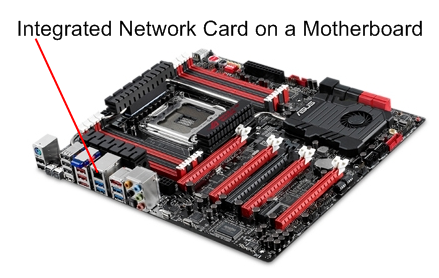- Related articles
- What Is Distribution Fiber Optic Cable (GJPFJV II)?
- What Is 1000 Mbps Network Card?
- How do they differ? PCI vs PCI-E vs AGP
- All Cisco SFP-10G-BXD-I’s Information (Overview, Features, Data Sheet PDF, Price, Specifi
- Move to 40G Today? Yes!
- What Is GYFTA Fiber Optic Cable?
- What is QSFP transceiver?
- Optical Transceivers for Cisco IE-4000-16T4G-E Switch
- Optical Transceivers for Cisco N9K-X9464PX= Switch
- Optical Transceivers for Cisco WS-C2960X-24TS-L Switch

Integrated network card is integrated into the card on the motherboard, and began to appear very early, especially with the popularity of various ADSL broadband access ways, the demand for network cards have also increased. So the network card integrated into the motherboard gradually adopted by the manufacturers.

What is integrated network card?
An integrated network card is an internal computer component that gives the machine the ability to connect to a network. The component might be designed to connect to a wired network, or to a wireless network. A machine might have also have both types of network cards installed. An integrated network card designed for wired networks is sometimes called an Ethernet card, while the wire-free cards are wireless cards.
What is integrated network card used for?
When designed for wired networks, an integrated network card features an RJ45 port for plugging in an Ethernet cable. The RJ45 port looks similar to a standard phone jack, but larger. The Ethernet cable runs from the machine to the network’s router or hub, physically linking the computer to the network. These network cards were once standard in all computers but are now optional in many mobile models, as wireless networks are more commonly used.
An integrated network card designed for connecting to a wireless router contains a built-in receiver and transmitter for operating over radio frequency (RF) waves. These cards are sometimes called WiFi™ cards, but technically, a true WiFi™ card is certified by the WiFi™ Alliance. Non-certified cards are sometimes referred to as “wifi” as a slang for wireless, without implicating certification. Certified or not, all wireless cards are made to comply with international standards to be interoperable with wireless routers and other wireless devices.
Types of integrated network card
Motherboard integrated network card has 10M / 100M, DUAL card, Gigabit Ethernet and wireless network card and other types. For large data networks, the server should use Gigabit Ethernet network card, which is used for server-to-switch connections for improving the overall system response rate. The 10M / 100M network card is the most commonly used and is the cheapest network chip, it is commonly used for file sharing applications. The DUAL network card technology is the most practical technology for user who use of broadband and other applications, and the price is affordable.
There are some strengths and weaknesses of integrated network card you need to know:
Strengths:
- Low cost
- Easy to use
- High integration, high practicability, can meet the needs of most of the application in daily life.
Weaknesses:
- Not easy to repair once damaged.
- Inconvenient to drive for the older or uncommon chips (such as REALTEK 8201CL, etc.)
- Performance is not very good, cannot meet the needs of some people.
Summary
Nowadays, the motherboard is not just integrated sound card, now motherboard integrated network card also appeared many other new technologies. NIC has become an indispensable part of the motherboard. Network application is so important, we need to attention of the integrated network card on the motherboard when purchase and to see which motherboard integrated network card is more suitable for you.





















































